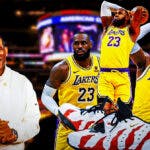“What ifs” are very common in professional sports. What if Player X didn't get injured? What if Team X didn't make that trade? What if X scenario happened the year before? What if Rajon Rondo developed a consistent jump shot?
Okay, that last one is awfully specific, but it is a question that many have asked since Rondo ascended to stardom just over a decade ago.
Just how good would Rondo have been had he become a decent perimeter shooter, and why was he never able to get to that point?
In Rondo's defense, he has made great strides in improving his outside shot over the last few years. Dating back to the 2015-16 campaign, Rondo has shot 36.5 percent, 37.6 percent, 33.3 percent, 35.9 percent and 32.8 percent, respectively, from 3-point range.
Of course, his volume hasn't been significant throughout that span, as he has only attempted three triples per game once (he took 3.1 treys a night in 46 games with the Los Angeles Lakers in 2018-19), but it is still a marked change from Rondo's Boston Celtics days when he took under one three per game five times in seven and a half seasons.
Even with these improvements, though, opposing defenses don't bother guarding Rondo beyond the 3-point line, leaving him wide open and effectively daring him to shoot. While he's a bit more willing these days, his presence still sometimes hurts the offense.

There are multiple reasons as to why Rondo was simply not able to get his perimeter shot down.
First of all, he just naturally isn't a very good shooter.
In two seasons at Kentucky, Rondo shot 28.3 percent from long distance on 1.5 attempts per game. He also made just 57.7 percent of his free throws, a trend that has, for the most part, continued in the NBA. He's a career 60.6 percent free-throw shooter as a pro and rarely gets to the line.
Rondo has awkward form, as his shooting elbow flies out rather than staying level like a good shooter's should. He also has a rather strange release, and perhaps due to his gigantic hands, he has never been able to find that sweet spot in terms of how to hold the ball while taking a jump shot.
Second, Rajon Rondo didn't really have to shoot early on in his career.

Yes, the Celtics were terrible during his rookie campaign, but that ensuing summer, Boston landed both Ray Allen and Kevin Garnett in separate trades, giving the club a dynamic trio that also included Paul Pierce.
Clearly, Rondo wasn't going to need to do much scoring in that lineup. That continued all the way through the summer of 2012, when Allen departed the C's for the Miami Heat. Heck, even that following season, the Celtics still had Garnett and Pierce as well as guys like Jason Terry and Courtney Lee to handle the scoring load (Rondo ended up tearing his ACL halfway through that campaign).
Particularly early on, Rondo was merely asked to play defense, distribute the basketball and essentially not mess up. He played that part very well as a youngster, as Rondo quickly developed into an elite perimeter defender, and his passing skills and superb floor vision were very obvious from the jump.
It wasn't until the 2009 playoffs, when Garnett was sidelined due to a knee injury, when Rondo truly emerged as a star. By 2010, there were some who actually felt Rondo was the Celtics' most important player (he wasn't; it was always Garnett).
But still, even as Rondo grew and emerged as a legitimate star, he remained Boston's fourth scoring option behind Pierce, KG and Allen. By that point, Rondo had already become accustomed to his role, and for as stubborn and moody as the mercurial floor general was in Beantown, he was incredibly unselfish on the court and deferred more often than not (sometimes to a fault).
Unfortunately for Rajon Rondo, the NBA landscape begin to change underneath his feet.

Players like Rondo became something of an ancient relic within a few years. The game became much more tailored to silky-smooth sharpshooters like Stephen Curry rather than rough riders like Rondo. The ability to shoot the 3-ball became a must, regardless of what position you played. Pretty soon, it became obvious that Rondo was a thing of the past.
Since being traded from the Celtics midway through the 2014-15 campaign, Rondo has tried to get with the times. While he hasn't necessarily reinvented himself, he has clearly been working hard on his perimeter shot, and it has produced admirable results. No, he isn't Steph, but he isn't the cumbersome shooter he was a decade ago.
The problem is, it's now too late for Rondo. He's 34 years old, and the ACL tear clearly sapped him of some of his magic. He can still dial it up every now and then, especially in the playoffs, where “Playoff Rondo” has become somewhat of an annual thing (save last year, when he and the Lakers missed the postseason entirely).
He's still a wily veteran. He's still a terrific defender when he wants to be. He's tough. He remains a valuable piece on a contending team given his experience and his abrasive personality which, while difficult, helps keep everyone else in line.
But you just can't help but wonder what could have been had Rajon Rondo developed a respectable jumper earlier. He was a top two or three point guard in the league even without the perimeter. Just imagine how lethal he would have been had he shot the 3-pointer well?




